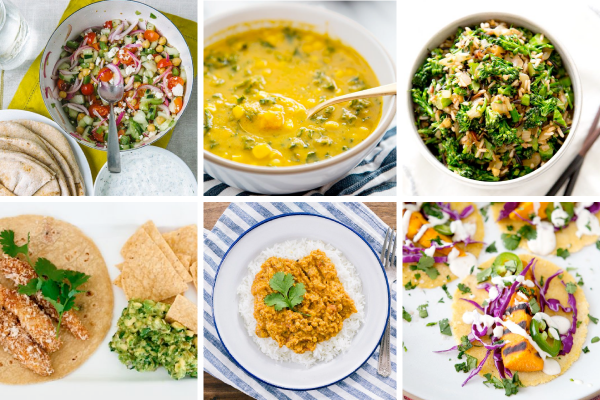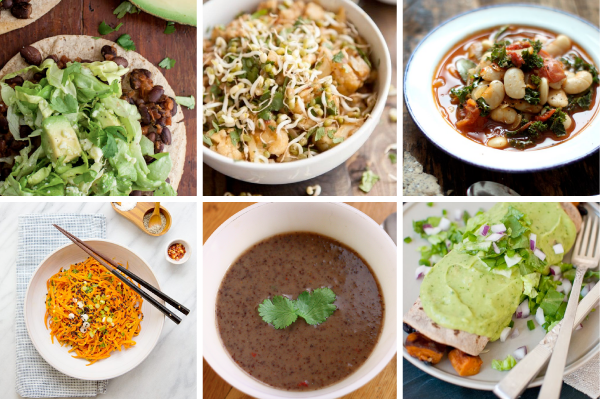What we eat, part two
Friends, thank you for your thoughts on part one! I heard from a few of you in the comments and in person that it sparked conversation, and I love that – not only because now you’re in the same boat as me (ha!) but because I think what we eat is a worthwhile thing to think and talk about. So let’s continue!
One thing that frustrated me about Forks Over Knives is that it included very little practical information – like, what a FOK-approved meal might look like. This post will be my attempt to fill in the gaps, at least relative to our life.
Let’s start with a few resources we’ve found helpful. Some of our favorite clean and whole recipes have come from A Couple Cooks, Naturally Ella, and A House in the Hills. We also like Pinch of Yum and Cookie + Katie. Since we’re looking for recipes that can be made for dinner on a regular weeknight when we get home from work, we need them to be both realistic and delicious, and these folks have come through time and again.
To get even more specific, I’ve sprinkled twelve of our favorite recipes throughout this post. More recipes we’ve liked are here, and recipes we have our eye on are here!
Greek pita sandwiches; sweet potato, kale, and corn chowder; broccolini fried rice; panko crusted fish tacos, spiced red lentils and rice, grilled sweet potato tacos with lime crema
There are a few foods we’ve had in heavy rotation during this transition. Number one is sweet potatoes. In addition to being really good for you, they are one of the best substitutes for meat in that they’re substantial, filling, and can take on lots of different flavors. They also take a long time to go bad, are inexpensive, and taste about the same year round. We eat them a LOT.
Almost every night we eat a salad with spinach, arugula, and sometimes kale. We often add cashews, pumpkin seeds, and sometimes cheese (feta for John, goat for me). I love our dressing – a basic vinaigrette we make (3 Tbs. olive oil, 2 Tbs. red wine vinegar, and 1 Tbs. mustard – shake it/store it in a mason jar).
We’ve cut out a LOT of pasta at home, substituting brown rice noodles, homemade vegetable noodles (just ribboning carrots, sweet potatoes, or zucchini with a peeler), or brown rice.
We’ve also switched or added a few specific products:
— Tropicana OJ has been replaced by the Whole Foods 365 brand 100% Florida orange juice thanks to this article.
— Coconut oil often replaces butter (though not always).
— John’s twice daily Coke Zeros are now Honest Fizz root beer, a can of Steaz, or water.
— The only ingredients in our peanut butter are now peanuts and salt.
— I’ve switched to KIND granola bars as a snack.
— I do drink some whole or 2% milk; it now comes from a farm in the next county over – the same one where we go for ice cream (I’ve even taken a tour!). It’s available at our Whole Foods.
We definitely have more changes we’d like to make (for example, I often eat buckwheat waffles or granola for breakfast, and I’d like to start making both myself), but it’s a process.
Also, just as a reminder, we are still eating sugary and processed things on occasion! Our belief is that if we feed our bodies a regular diet of the good stuff, it can (sparingly) handle the bad stuff. Because sometimes the bad stuff is delicious :)
Black bean tostadas with avocado salad; spicy peanut sauce with brown rice noodles; garlicky kale and white bean stew; carrot noodles in peanut sauce; black bean soup with cumin and jalapeno; sweet potato burritos with avocado salsa verde
One question Whitley asked on my last post that I wanted to address was this: “I think one of the things that scares me most about “clean” eating is the perception that it’s more expensive. Have you found this to be true?”
I’m glad she asked, because I have a few thoughts about this! First, though the amount of our food budget has not changed dramatically in this transition, I would not have been surprised or particularly upset if it had. For other things I care about, I expect to pay more for quality, so naturally, I wouldn’t be surprised if better food cost more. In the long term, when taking quality of life and healthcare into account, I expect it to be far less expensive than other ways of eating.
Michael Pollan also points out in The Omnivore’s Dilemma that the percentage of the average household budget allocated for food has steadily decreased over the past few decades, at the same time as food has generally gotten less nutritious. We’ve become accustomed to getting more for less, but in order to pay for the things I care about (happy animals, sustainable and Earth-friendly farming practices), I am willing to pay more (and readjust/make room in my budget accordingly).
As someone who truly believes in the power of free market forces, I believe that we are casting a vote with every beep of the supermarket scanner. With my dollars and my choices, I can tell Whole Foods and Walmart and every brand they stock what I want to see more of. The thought almost makes me giddy! :)
However, even though important, I know that’s probably not what Whitley meant, and so I’ll answer the other way, too. Our biggest expense has always been and still is wasting food – letting meat go bad before putting it in the freezer or using it, leaving lettuce to wilt, or buying a jar of something and only using a teaspoon before it expires. Sticking to a weekly meal plan greatly helps with this, as does regularly taking stock of our pantry and refrigerator – and keeping both neat and organized so that things don’t get shoved to the back and forgotten.
Second, though we do about half of our shopping at Whole Foods (most of our vegetables, and packaged food we can’t find elsewhere) the rest is done at Walmart. We’ve found that many (though hardly all) brands we could buy at WF are available at Walmart for less, including Stonyfield, Annie’s, and Kind. We also tend to buy bananas and root vegetables like garlic, potatoes, and onions at Walmart because the quality is comparable (unlike more perishable things like fruit or tomatoes). So, being smart about where we buy helps keep our costs down. The 365 brand at Whole Foods also offers some great savings.
It’s not new advice, but things tend to taste better and cost less when you buy them in season and, if possible, when you pick them yourself. Berries, of course, are the perfect example – we love picking strawberries in the spring and blueberries in the summer, both of which we can do ten minutes from our house.
Since we only eat meat about once a week now, we can afford to buy happy animals and still have some savings left over to soak up other new expenses. Depending on what your current diet is, some of those expenses might be new oils, spices, or other ingredients you haven’t used before (like coconut oil and tamari for us!).
To finish, I wanted to note that one thing we are excited to explore more is buying local. The pastoral section of The Omnivore’s Dilemma really inspired me on this point, with its description of Joel Salatin’s farm (which some of you might remember from Food Inc.). A few weeks ago we bought a chicken at our town’s farmer’s market that had hatched, was grown, and then processed the day before about ten minutes from our house. We bought it from the person who did it. Joel suggests this site and this site for finding other local sources for sustainably raised food (in addition to farmer’s markets!).
Whew! I’m glad we’re at the end of this post, because now it’s your turn: I would love to hear your go-to resources and recipes for clean, whole, and easy recipes! Thank you in advance :)





















I’m 100 pages into The Omnivore’s Dilemma, and while it took me a bit to “get into it” as Pollan’s writing is wordy and detailed, I’m glad I pressed through. I’m reading it with ease now, and I’m enjoying it! I agree: his calm approach is so refreshing in our frenzied culture. What a great book – a must read for today!
PS. I’m adding lots of these recipes to our grocery list for May. Thanks for sharing! I’m particularly excited to try the Sweet Potato, Kale and Corn Chowder!
Thank you so much for answering my question! It’s so great to know that big-box stores like Walmart also offer clean eating options and I don’t have to do ALL my shopping at Whole Foods or other organic markets. I’m excited to explore some healthier options especially with summer coming up!
I actually read parts of your earlier post aloud to my husband because I was just so excited to see other people eat like we do! I’ve found our primarily plant-based diet makes us both feel good, but being able to bring a coconut cream pie to a dinner party and enjoy it is part of a well-lived life, too. Cheers to clean living and good eating!
Thank you so much for providing all of this practical advice. I sometimes find myself asking “I know what I should do, but HOW do I do it?” I’ve been making gradual changes over time, but I feel like now is the time to make big changes (although I know cutting out Coke Zero is not going to be fun). With summer coming, I am so looking forward to working in my new garden, visiting the Farmer’s Market and buying local!
I totally just wrote a post today about eating better and didn’t know you were doing a series! I plan on coming back for more inspiration so keep’em comin’!
xoxo
Check out 100daysofrealfood.com. It has been a great resource for recipes and learning about “real” food.
I have recipes for almond-flour pancakes and protein cookies I really like. Both really stick with you; they help avoid later snacking on junk. My closest Whole Foods is 35-40 minutes away, so I really have to think carefully about what I need to buy there as opposed to elsewhere, and how often I need to go.
I love your mindset of still allowing yourself ‘unhealthy’ treats from time to time. I follow a similar sort of diet, and it works out well for me!
Wow… all these recipes look amazing!
You are right, sweet potato is awesome–particularly roasted with ghee and cinnamon. Oh my.
I eat a “paleo-ish” diet about 80% of the time–so mostly meat, nuts, fruit and veggies. I find that work for me. :)
Good for you for striving to make healthier choices for your family! :)
So excited to look through the blogs you mentioned and find some new things to try! My go-to blogs for healthy recipes right now are Eat Yourself Skinny, since her recipes are easy and use ingredients I already have (plus, she’s an SW reader and Southern Bride Blogger!), and Oh She Glows, for vegan recipes, healthy remakes of recipes, and salads.
I’ve briefly read over both of your food posts. I want to sit down and really dive in though because I love this approach to eating. I feel my family eats pretty healthy, but we could make more changes…..like not eating pasta from a box! My husband’s fave food is pasta though :(. 100daysofrealfood.com is a great resource as well.
Thanks for sharing your journey and findings, Em! Having visited Polyface, I’ve seen in person how much better such a natural, organic way of farming is for the animals and people!
I’m late commenting on this, but I want to say thank you for these posts! I had been trying to buy less meat lately (more from a financial standpoint) but had trouble coming up with a good variety of vegetarian meals. I love the blogs you refer to and I’ve already tried several recipes you posted here with great success and I can’t wait to try more!
Love this post, Emily! Can’t wait to read more thoroughly tonight.
Emily! This is truly marvelous! My husband and I are talking through making some radical changes to our diet, also because of things like Forks over Knives and Food Inc. I’ve also read some of Michael Pollan and we’re halfway through Eat to Live. I love that you included recipes, too! My husband refuses to have kale in a smoothie, but I definitely think he could handle that sweet potato chowder ;)
We love sweet potatoes as well…Minimalist Baker did a Shepherd’s Pie recipe a while back, but used lentils instead of meat. We did mashed sweet potatoes over the top, and it was delectable.